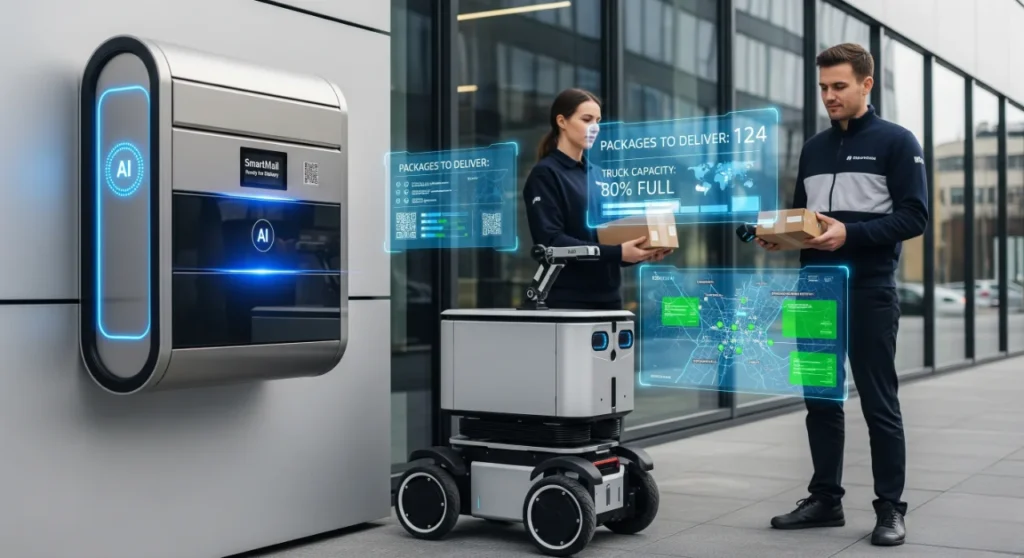Arrive AI is betting that smarter mailboxes can fix one of delivery’s oldest headaches.
The company has unveiled new time-of-flight (TOF) sensors for its patented Arrive Points™, aiming to eliminate wasted courier stops, reduce congestion, and make last-mile delivery faster and cheaper.
Key Takeaways
- Arrive AI adds TOF sensors to streamline pickups and courier efficiency.
- Sensors cut wasted stops, fuel use, and delivery congestion.
- Edge AI analysis avoids bulky cameras and processors.
- Patents cover drone delivery, anti-theft, and chain-of-custody systems.
Arrive AI is deploying time-of-flight (TOF) sensors in its patented Arrive Points™ smart mailboxes to reduce wasted courier stops and optimize truck capacity. The sensors, powered by edge AI, cut costs, speed up deliveries, and improve courier reliability while eliminating the need for cameras or expensive processors.
Smarter Sensors for a Smarter Last Mile
Arrive AI is doubling down on the last-mile delivery problem. This week, the company announced it will embed time-of-flight (TOF) sensors into its flagship Arrive Points™, creating what it says is a leap forward in package logistics.
The move targets a long-standing inefficiency: couriers making unnecessary stops to check for outgoing packages. With TOF-equipped smart mailboxes, couriers — whether human drivers, ground robots, or drones — will know in advance which locations need service and how much space is required on each truck.
“Time is money, and even small gains in logistics efficiency add up fast,” said CEO Dan O’Toole in a company statement.
The Tech Behind It
Unlike high-resolution cameras, TOF sensors use low-resolution depth data to determine whether items are present. The data is processed at the edge using lightweight AI, keeping hardware costs down and maximizing storage space for parcels.
“We can do a lot with a little,” added Chief Technology Officer Torrey Bievenour, noting that Arrive’s R&D team is training models to identify package counts, sizes, retrieval times, and courier efficiency pattern.
Why It Matters
Last-mile delivery is often the most expensive and carbon-intensive part of the supply chain. Reducing unnecessary stops not only lowers fuel and battery use but also shrinks delivery times and urban congestion. For cities struggling with traffic and sustainability goals, technologies like Arrive’s could become crucial infrastructure.
A Patent-Heavy Bet
Arrive AI’s innovation isn’t just about sensors. The company holds multiple U.S. patents, including for drone tethering, anti-theft mechanisms, and climate-controlled storage. With 58 patents pending in 22 countries, Arrive is signaling that it wants to be a long-term player in autonomous last-mile logistics.
O’Toole’s vision dates back to 2014, when he filed the first patent for a drone-compatible smart mailbox. Today, that concept has evolved into a platform integrated with smart home devices, IoT systems, and delivery alerts.
Human Reaction: The Courier’s Perspective
For couriers, efficiency is everything. “I lose almost an hour a day just checking empty boxes,” said Marcus R., a courier in Chicago who reviewed the announcement. “If these mailboxes tell me exactly where to stop, that’s gas saved and time back in my pocket.”
Numbers to Watch
- 58 patents pending across 22 countries for autonomous delivery solutions.
- 2017: Year O’Toole secured the first U.S. patent for drone-ready smart mailboxes.
- 1 hour/day: Estimated courier time wasted on empty mailbox checks.
What’s Next
- Expansion of TOF-equipped Arrive Points into U.S. metropolitan hubs.
- Integration with autonomous drone and robot couriers.
- Potential licensing of the platform to logistics giants like FedEx, UPS, or Amazon.
- Further AI applications in courier performance tracking and supply chain optimization.
Conclusion
Arrive AI’s sensor upgrade tackles the last-mile delivery problem with precision and practicality. By combining smart hardware with edge AI, the company is reshaping how packages move through cities — faster, cleaner, and more secure.
If last-mile inefficiency can be solved, could this be the blueprint for drone-and-robot-friendly neighbourhoods tomorrow?
